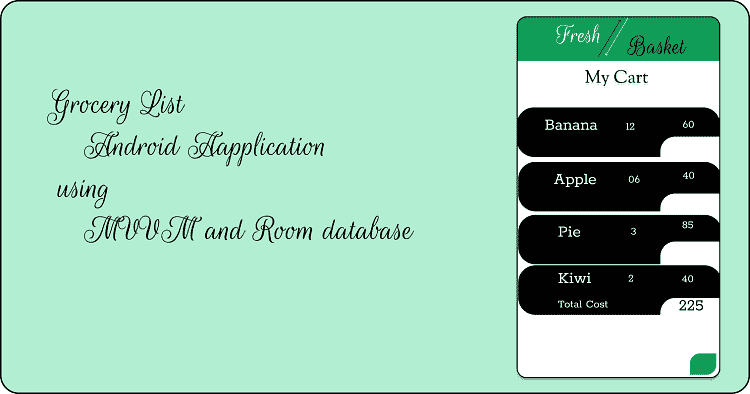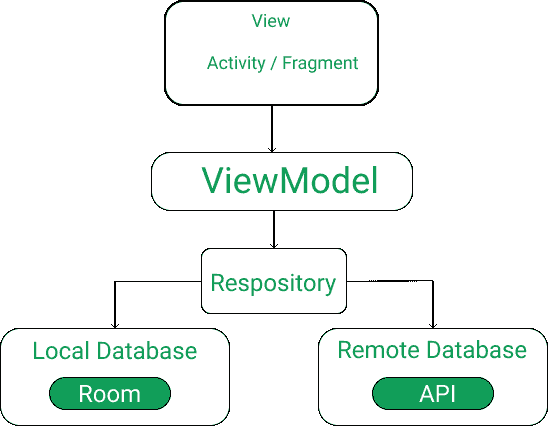如何使用 MVVM 和房间数据库构建一个杂货安卓应用?
原文:https://www . geesforgeks . org/how-to-build-a-杂货-Android-app-using-mvvm-and-room-database/
在本文中,我们将使用 android studio 在 android 中构建一个杂货应用程序。很多时候我们会忘记购买自己想买的东西,毕竟我们不可能记住所有的物品,所以借助这个 app,你可以记下你要购买的杂货物品,这样做你就不会忘记任何你想购买的物品。下面给出了一个示例图像,以了解本文中要做什么。请注意,我们将使用 Kotlin 语言来实现这个项目。

在这个项目中,我们使用 MVVM(模型视图视图模型)作为建筑模式,房间作为数据库, Coroutines 和recycle View来显示项目列表。在跳到项目之前,让我们先了解一下这些术语。
MVVM(模型视图视图模型)
android 中的 MVVM 架构被用来给项目的代码赋予结构,并且容易理解代码。MVVM 是安卓系统中的一种建筑设计模式。MVVM 将活动类和 XML 文件视为视图。这种设计模式将用户界面与其逻辑完全分离。下面是一个快速了解 MVVM 的图片。

看到这张图片后,如果你不明白它将如何工作,那么不要担心,因为我们将编写我们完全理解它的代码。
房间数据库
房间持久性库是一个数据库管理库,用于存储应用程序的数据,如杂货项目名称、杂货项目数量和杂货项目价格。房间是 SQLite 上的一个覆盖层,有助于轻松对数据库进行操作。
回收视图
RecyclerView 是一个容器,用于显示大量数据集中的数据集合,通过维护有限数量的视图,可以非常有效地滚动这些数据。
协同程序
coroutine 是一个轻量级线程,我们使用 coroutine 在其他线程上执行操作,这样我们的主线程就不会阻塞,我们的应用程序也不会崩溃。
分步实施
第一步:创建新项目
要在安卓工作室创建新项目,请参考如何在安卓工作室创建/启动新项目。注意选择科特林作为编程语言。
第二步: 先去编码区之前,你要做一些前置任务
在进入编码部分之前,首先将这些库添加到你的渐变文件中,并将插件作为“kotlin-kapt”应用。要添加这些库,请转到梯度脚本>构建.梯度(模块:应用程序)。
def room_version = "2.2.1 "
def lifecycle_version = "2.0.0 "
//房间和建筑构件
实现“androidx . room:room-runtime:$ room _ version”
实现“androidx . legacy:legacy-support-v4:1 . 0 . 0”
实现“androidx . life cycle:life cycle-extensions:2 . 1 . 0”
实现' androidx . life cycle:life cycle-view model-ktx:2 . 1 . 0 '
实现“androidx.room:room-ktx:2.2.1”
kapt“androidx . room:room-编译器:$room_version”
// Coroutines
实现' org . jet brains . kot linx:kot linx-coroutines-core:1 . 3 . 0 '
实现" org . jet brains . kot linx:kot linx-coroutines-Android:1 . 3 . 0 "
//新材料设计
实现“com . Google . Android . material:material:1 . 0 . 0”
// ViewModel
实现“androidx . life cycle:life cycle-extensions:$ life cycle _ version”
实现“androidx . life cycle:life cycle-view model-ktx:$ life cycle _ version”
kapt“androidx . life cycle:life cycle-编译器:$lifecycle_version”
以下是 build.gradle(:app) 文件的完整代码。
我的锅
apply plugin: 'com.android.application'
apply plugin: 'kotlin-android'
apply plugin: 'kotlin-android-extensions'
apply plugin: 'kotlin-kapt'
android {
compileSdkVersion 29
buildToolsVersion "30.0.3"
defaultConfig {
applicationId "com.example.grocerylist"
minSdkVersion 16
targetSdkVersion 29
versionCode 1
versionName "1.0"
testInstrumentationRunner "androidx.test.runner.AndroidJUnitRunner"
}
buildTypes {
release {
minifyEnabled false
proguardFiles getDefaultProguardFile('proguard-android-optimize.txt'), 'proguard-rules.pro'
}
}
compileOptions {
sourceCompatibility = 1.8
targetCompatibility = 1.8
}
kotlinOptions {
jvmTarget = "1.8"
}
}
dependencies {
implementation fileTree(dir: 'libs', include: ['*.jar'])
implementation "org.jetbrains.kotlin:kotlin-stdlib-jdk7:$kotlin_version"
implementation 'androidx.appcompat:appcompat:1.0.2'
implementation 'androidx.core:core-ktx:1.0.2'
implementation 'androidx.constraintlayout:constraintlayout:1.1.3'
testImplementation 'junit:junit:4.12'
androidTestImplementation 'androidx.test.ext:junit:1.1.1'
androidTestImplementation 'androidx.test.espresso:espresso-core:3.2.0'
def room_version = "2.2.1"
def lifecycle_version = "2.0.0"
// Room and Architectural Components
implementation "androidx.room:room-runtime:$room_version"
implementation "androidx.legacy:legacy-support-v4:1.0.0"
implementation 'androidx.lifecycle:lifecycle-extensions:2.1.0'
implementation 'androidx.lifecycle:lifecycle-viewmodel-ktx:2.1.0'
implementation "androidx.room:room-ktx:2.2.1"
kapt "androidx.room:room-compiler:$room_version"
// Coroutines
implementation 'org.jetbrains.kotlinx:kotlinx-coroutines-core:1.3.0'
implementation "org.jetbrains.kotlinx:kotlinx-coroutines-android:1.3.0"
// New Material Design
implementation "com.google.android.material:material:1.0.0"
// ViewModel
implementation "androidx.lifecycle:lifecycle-extensions:$lifecycle_version"
implementation "androidx.lifecycle:lifecycle-viewmodel-ktx:$lifecycle_version"
kapt "androidx.lifecycle:lifecycle-compiler:$lifecycle_version"
}
下面是 strings.xml 文件的代码。在这里,我们添加了将在项目中使用的必要字符串。
可扩展标记语言
<resources>
<string name="app_name">Fresh Basket</string>
<!-- TODO: Remove or change this placeholder text -->
<string name="hello_blank_fragment">Hello blank fragment</string>
<string name="itemName">Banana</string>
<string name="itemQuantity">35</string>
<string name="itemPrice">250Rs</string>
<string name="totalCost">20</string>
<string name="totalCostTitle">Total Cost</string>
<string name="title">Add Items to your cart</string>
<string name="etItem">Item</string>
<string name="etQuantity">Quantity</string>
<string name="etPrice">Price</string>
<string name="save">Save</string>
<string name="cancel">Cancel</string>
</resources>
下面是 colors.xml 文件的代码。在这里,我们添加了必要的颜色,我们将在我们的项目中使用。
可扩展标记语言
<?xml version="1.0" encoding="utf-8"?>
<resources>
<color name="colorPrimary">#0AD042</color>
<color name="colorPrimaryDark">#03551A</color>
<color name="colorAccent">#03DAC5</color>
<color name="black">#000000</color>
<color name="white">#ffffff</color>
</resources>
第三步:实现房间数据库
a)实体类
entities 类包含数据库中的所有列,应该用@Entity(tablename =“表的名称”)进行注释。实体类是一个数据类。@Column info 注释用于输入列变量名和数据类型。我们还将添加主键用于自动增量。转到app>Java>com . example . application-name。右键单击com . example . application-name转到新建并创建 Kotlin 文件/类,并将该文件命名为 GroceryEntities 。看下面的代码来完全理解和实现。
我的锅
package com.example.grocerylist.Database.Entity
import androidx.room.ColumnInfo
import androidx.room.Entity
import androidx.room.PrimaryKey
// This is a data class which store data.
// Entities class create a table in database,
// in our database we will create three column
@Entity(tableName = "grocery_items")
data class GroceryItems(
// create itemName variable to
// store grocery items.
@ColumnInfo(name = "itemName")
var itemName: String,
// create itemQuantity variable
// to store grocery quantity.
@ColumnInfo(name = "itemQuantity")
var itemQuantity: Int,
// create itemPrice variable to
// store grocery price.
@ColumnInfo(name = "itemPrice")
var itemPrice: Int
) {
// Primary key is a unique key
// for different database.
@PrimaryKey(autoGenerate = true)
var id: Int? = null
}
